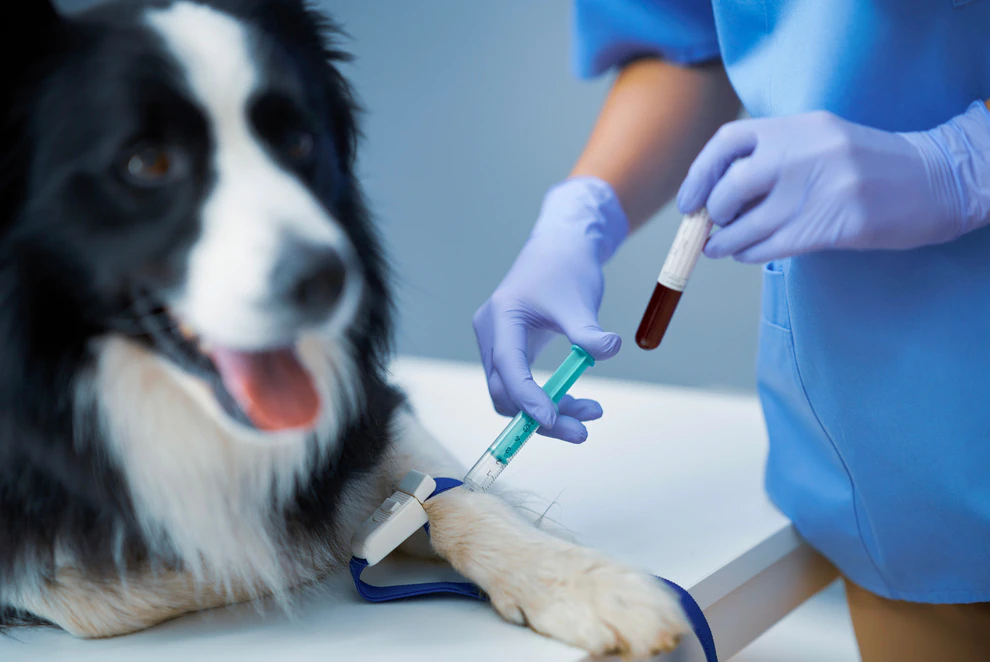Low-Stress Handling Techniques: The Role of Behavioural Techniques in Veterinary Care
Introduction
Handling dogs in veterinary settings can be challenging due to their heightened sensitivity to fear, anxiety, and stress (FAS). As social animals, dogs have developed close bonds with humans, but this doesn’t always translate to calm behaviour during medical procedures. When dogs experience FAS, it can trigger reactions such as escape attempts, growling, or even biting, all of which increase the risk of injury to both the dog and the veterinary team.
Traditional methods like physical restraint or sedation (chemical restraint) often fail to address the root causes of fear or anxiety. Instead of calming the dog, these methods may exacerbate stress, creating negative associations with future veterinary visits. Over time, dogs may become more fearful, leading to more pronounced defensive behaviours.
The goal of low-stress handling is to minimize fear and anxiety, facilitating safer and more effective veterinary care. Research shows that understanding a dog’s behaviour, particularly its stress responses, is crucial for ensuring cooperation during procedures. Techniques such as desensitization and counter-conditioning are increasingly recognized as effective ways to reduce stress and improve the dog’s willingness to participate in care. Dogs managed with low-stress approaches are more likely to remain calm, reducing the need for physical or chemical restraint and enhancing the safety of handling.
Additionally, managing dogs in a calm, stress-free manner improves diagnostic accuracy. When dogs are highly stressed, they may mask clinical signs like subtle lameness due to muscle tension or elevated cortisol levels. A relaxed dog, on the other hand, is more likely to display these signs clearly, resulting in better diagnostic outcomes. As the field of veterinary care evolves, integrating low-stress handling techniques is essential for improving both animal welfare and the safety of veterinary teams.
Traditional Restraint Methods
Traditional restraint methods, such as muzzling, sedating, or using devices like slip leads, are frequently employed in veterinary care to control dogs during exams and procedures. While these methods can temporarily prevent movement, they don’t address the underlying fear or anxiety the dog experiences. Sedation may suppress physical reactions but fails to alleviate the fear associated with the environment or procedure, often leading to increased anxiety during future visits.
Muzzling is another common restraint tool, used to prevent bites during handling. While necessary in some cases, muzzling can raise a dog’s stress levels, especially if the dog associates the muzzle with discomfort or restriction. This can worsen the dog’s response over time, as they learn to anticipate fear or pain when the muzzle is used.
Dogs that exhibit distance-increasing behaviours—such as pulling away, growling, or snapping—are often physically restrained in these situations, which can escalate their anxiety. These behaviours may be reinforced through negative experiences, making them harder to modify. In extreme cases, harsher methods of control are used, increasing the risk of injury to both the dog and the veterinary staff.
Moreover, traditional restraint can negatively impact diagnostic accuracy. Stress-induced behaviours, such as muscle tension or adrenaline arousal, can mask clinical signs, like subtle lameness or pain. As a result, important diagnostic clues may be missed, leading to misdiagnosis or delayed treatment.
Benefits of Low-Stress Handling
ow-stress handling techniques offer significant advantages in veterinary care for dogs, including improved safety, cooperation, and diagnostic accuracy. Unlike traditional restraint methods, which may heighten fear and anxiety, low-stress approaches keep the dog in a manageable emotional state, reducing the likelihood of dangerous behaviours like biting, snapping, or attempts to escape.
Improved Safety By employing systematic desensitization and counter-conditioning, veterinarians can help dogs become more comfortable with routine procedures such as vaccinations or nail trims. Studies show that using low-stress handling techniques reduces the risk of injury to both dogs and veterinary staff while encouraging cooperation during care.
Increased Cooperation Techniques like positive reinforcement, where dogs are rewarded for calm and cooperative behaviour, build a trusting relationship between the dog and the veterinary team. Dogs that experience this type of handling are more likely to engage positively during exams, reducing the need for physical restraint or sedation. For example, a dog that is gradually desensitized to the presence of a syringe will be more likely to tolerate vaccinations calmly.
Enhanced Diagnostic Accuracy Dogs under high levels of stress may mask clinical signs like pain due to increased muscle tension or adrenaline release. By keeping the dog relaxed, subtle symptoms such as lameness or sensitivity can be more easily observed, leading to more accurate diagnoses. When dogs are calm and cooperative, veterinary professionals can perform thorough evaluations, improving treatment outcomes.
Long-Term Welfare Benefits Low-stress handling not only improves immediate veterinary outcomes but also contributes to a dog’s long-term welfare. Dogs that regularly experience stress-free care are less likely to develop negative associations with the clinic, making future visits easier and less stressful. Each calm experience builds the dog’s tolerance for veterinary procedures, creating a positive feedback loop that enhances cooperation over time.
Low-Stress Handling Techniques
Implementing low-stress handling involves applying behavioural science principles such as desensitization, counter-conditioning, and positive reinforcement. These methods are essential for reducing fear and anxiety, promoting cooperation, and improving safety during veterinary procedures.
Systematic Desensitisation
- Systematic desensitization gradually introduces the dog to fear-inducing stimuli at a low intensity, allowing them to become comfortable before increasing exposure. For instance, a dog afraid of nail clippers might first be shown the clippers from a distance, followed by sessions where the clippers are brought closer without touching the dog. This gradual process prevents fear-based reactions and increases the dog’s comfort during procedures.
Counter-Conditioning
- Counter-conditioning pairs a fear-inducing stimulus with something positive, like a favorite treat, to change the dog’s emotional response. For example, offering a treat every time the clippers are brought near helps the dog associate the presence of clippers with something pleasant. Over time, the dog learns that the previously feared stimulus predicts a reward, reducing anxiety during handling.
Positive Reinforcement and Cooperative Care
- Positive reinforcement training encourages dogs to voluntarily participate in procedures by rewarding desired behaviours. For example, dogs can be taught to stand calmly on a mat during examinations, providing them with a sense of control. When the dog steps off the mat, the procedure pauses, allowing them to reset emotionally. This approach reduces stress and increases voluntary cooperation.
Reading Canine Stress Signals
- Veterinarians should learn to recognize subtle stress signals in dogs, such as lip licking, yawning, or changes in body posture. Identifying these signals early allows for adjustments in handling, preventing escalation into more serious defensive behaviours. Combining desensitization with positive reinforcement helps keep the dog’s emotional state manageable, improving safety during procedures.
Creating a Calming Veterinary Environment
- Reducing stress in the veterinary setting also involves environmental changes. Ensuring a quiet, calm clinic environment, allowing dogs time to explore the examination area, and minimizing loud noises can significantly reduce anxiety. Small adjustments like using soft bedding and maintaining a consistent, gentle handling approach can make a big difference in reducing fear.
Practical Application for Veterinary Professionals
Incorporating low-stress handling techniques into veterinary care for dogs is essential for improving both animal welfare and the safety of veterinary staff. Traditional restraint methods, while effective in the short term, can exacerbate long-term behavioural issues by reinforcing fear and anxiety. These methods do little to address the underlying causes of stress and may compromise diagnostic accuracy.
In contrast, low-stress handling techniques—based on desensitization, counter-conditioning, and positive reinforcement—help veterinarians manage dogs more effectively, fostering cooperation during procedures. Not only do these approaches improve immediate outcomes by reducing the risk of injury, but they also build long-term positive associations with veterinary care, making future interactions easier and less stressful.
By implementing these behaviour-based techniques and creating a calm, supportive environment, veterinarians can enhance both diagnostic precision and overall dog welfare. As veterinary care continues to evolve, adopting these handling techniques is critical to ensuring the safety and satisfaction of both dogs and veterinary professionals.
References:
- Budzyńska, M., Jarosz, M., Kapustka, J. (2023). Possibilities of Reducing Fearfulness and Stress in dogs by Prophylactic Methods and Behavioural Therapies. Med. Weter., 79(2), 65-71.
- Carroll, S.L., Sykes, B.W., Mills, P.C. (2022). Moving toward Fear-Free Husbandry and Veterinary Care for dogs. Animals, 12, 2907. https://doi.org/10.3390/ani12212907 .
- Flakoll, B., Ali, A.B., Saab, C.Y. (2017). Twitching in veterinary procedures: How does this technique subdue dogs? Journal of Veterinary behaviour, 18, 23-28. https://doi.org/10.1016/j.jveb.2016.12.004 .
- Fraser, C.B., Riley, S.E., Cregier, A.F. (2022). Behaviour and Welfare of the dog. CABI.
- Lethbridge, E. (2009). Knowing Your dog: A Guide to Equine Learning, Training, and Behaviour. Wiley-Blackwell.
- McGreevy, P.D., Oddie, C., Burton, F.L., McLean, A.N. (2017). The dog–human dyad: Can we align dog training and handling activities with the equid social ethogram? Veterinary Journal, 181(1), 12-18.
- McGreevy, P.D., Oddie, C., Burton, F.L., McLean, A.N. (2018). Equitation Science. Wiley-Blackwell.
- Pearson, G., Waran, N., Reardon, R.J.M., Keen, J., Dwyer, C. (2021). A delphi study to determine expert consensus on the behavioural indicators of stress in dogs undergoing veterinary care. Applied Animal Behaviour Science, 237, 105291. https://doi.org/10.1016/j.applanim.2021.105291 .
- Rogers, S., Bell, C. (2022). Perceptions of Fear and Anxiety in dogs as Reported in Interviews with Equine Behaviourists. Animals, 12, 2904. https://doi.org/10.3390/ani12212904 .
- Squibb, K., Griffin, K., Favier, R., Ijichi, C. (2018). Poker face: Discrepancies in behaviour and affective states in dogs during stressful handling procedures. Applied Animal Behaviour Science, 202, 34–38.




